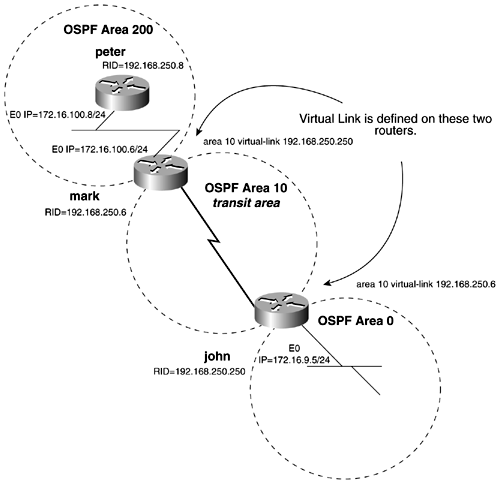Integrated Routing and Bridging
| < Free Open Study > |
OSPF Virtual LinksWe discuss OSPF virtual links last because they should be used as your last option. The Cisco design guide warns that the use of virtual links is an indication of poor design, and, for the most part, this is correct. Virtual links are used to extend Area 0 across another area. They also can be thought of as tunnels for LSAs. They are deployed in cases when areas become partitioned or an area does not border Area 0. To configure a virtual link, use the following router command: Router(config-route)# area transit_area_id virtual-link router_id_of_remote The area_id is the "transit area" that OSPF will tunnel through. The "transit area" cannot be a stub area of any kind. At the end of the tunnel will be another router terminating the virtual link; use the router ID of that router in the router_id field. Virtual links use RIDs, and they are another reason why we use fixed RIDs when configuring OSPF. It is important that any timer changes or OSPF authentication applied to Area 0 also must be applied to the other side of the virtual link. Remember that a virtual link is actually an extension of Area 0. Think of the virtual link as the router's new interface into Area 0. Configure all interface options on the virtual link. In Figure 12-13, the router peter is in Area 200. Notice that Area 200 does not directly touch Area 0. To make this network functional, you need to define a virtual link across Area 10. On the router mark, define a virtual link using Area 10 as the transit area, terminating it at the router ID of 192.168.250.250 or the router john. On the router john, configure a virtual link by using Area 10 as the transit area, and terminate the link at router ID 192.168.250.6. The precise syntax for each virtual link is highlighted in Figure 12-13. Figure 12-13. OSPF Virtual Links To verify the functionality of a virtual link, use the command show ip ospf virtual-links along with standard show ip route and ping tests . The virtual link should be up and the adjacency state should be FULL when it is operating properly. If the link does not come up, ensure that the router IDs are the ones that OSPF is using. View the OSPF database if you are unsure what the current router ID is. Example 12-31 lists the output of the show ip ospf virtual-links command performed on the router john. Example 12-31 Verifying a Virtual Linkjohn# show ip ospf virtual-links Virtual Link OSPF_VL0 to router 192.168.250.6 is up Run as demand circuit DoNotAge LSA allowed. Transit area 10, via interface Serial0.1, Cost of using 64 Transmit Delay is 1 sec, State POINT_TO_POINT, Timer intervals configured, Hello 10, Dead 40, Wait 40, Retransmit 5 Hello due in 00:00:09 Adjacency State FULL (Hello suppressed) Index 2/5, retransmission queue length 0, number of retransmission 1 First 0x0(0)/0x0(0) Next 0x0(0)/0x0(0) Last retransmission scan length is 1, maximum is 1 Last retransmission scan time is 0 msec, maximum is 0 msec john# |
| < Free Open Study > |
EAN: 2147483647
Pages: 283
